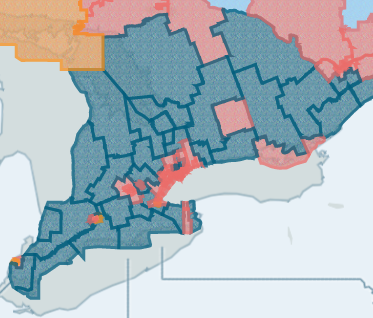The answer by Ray Butterowrth is correct, and I gave that answer an up-vote. However, there are lots of nuances to it.
For example, contributing factors for Toronto going liberal include a combination of hatred for Doug Ford, reminiscence over various figures in the recent political history such as Jack Layton, and strategic voting on the part of the NDP voters.
Doug Ford, the conservative prov. premiere, has a long history of annoying the more liberal or socialist leaning folk in Toronto. This has roots at least as far back as when Rob Ford, Doug's brother, was mayor of Toronto. So there is a significant feeling that anything connected with Doug Ford must be defeated.
Jack Layton was a highly popular NPD figure in Toronto. There is a lot of fondness for his memory. It produces a lot of loyalty to his party, quite outside of and even in contradiction to ideology.
A big thing in the Alberta and Saskatchewan is the ongoing struggle to decide what to do with and about oil produced there. Other resources as well such as wheat and lumber. This is at least as old as Pierre Trudeau, the father of our current PM. Various issues such as where pipelines are permitted, who has to pay how much for using them, what resources belong to who, and how much tax will be paid, among many other issues, have embittered relations between Ottawa and the Prairies for a very long time.
There are lots of other factors that tend to produce a divided country. For example, a quick glance at the map in the question would allow you to be fairly accurate as to guessing what regions are predominantly controlled by natives. They tend to strongly favor liberal or NDP candidates. This is a big part of the orange and red in the north and in BC. And Quebec is solidly Bloc Quebec, the dark green shade in the map. These groups all have separatist and cultural/language isolation issues that unite them and set them apart from the rest of the country.
This election is potentially troublesome for Canada. It's a deeply divided nation at the moment. Those different colored regions have some strong feelings of resentment and frustration.


